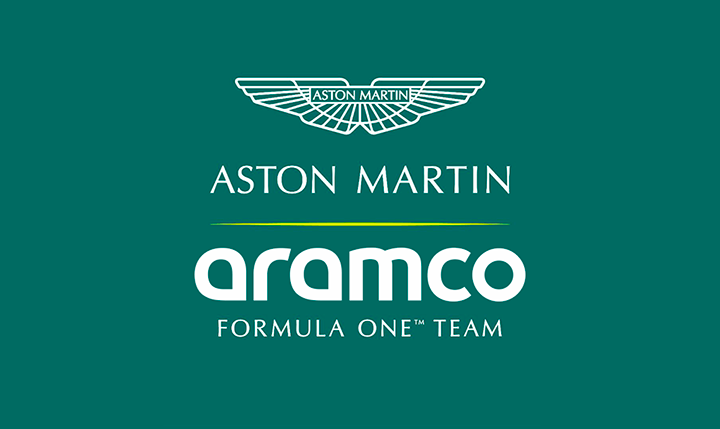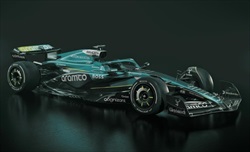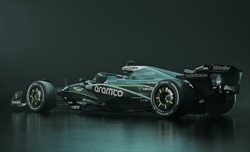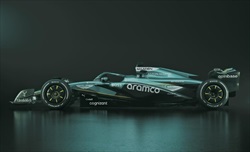Aston Martin Aramco Formula One Team
Silverstone, UK
www.astonmartinf1.com
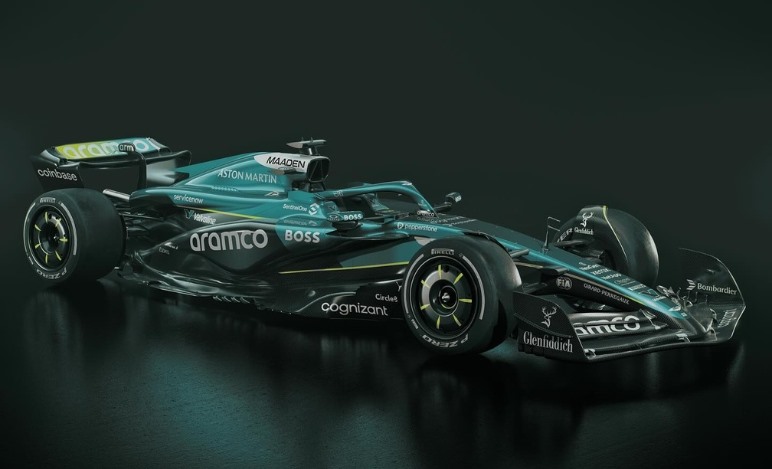
Team Chief: Mike Krack
Technical Chief: Adrian Newey
Sports Director: Enrico Cardile
Chassis 2025: AMR25
Engine: MercedesTyre: Pirelli
Reserve Driver: Drugovich Felipe
Season 2025
The team, after the exploits of 2023, faced a complicated season due to a single-seater that reacted poorly to upgrades and did not keep up with its rivals, going from fighting for the podium to fighting for the points zone, highlighting major problems in finding the right operating window and tire management.
Patron Stroll's determination remained unchanged and with a monstrous bid he managed to bring to Silverstone the brilliant designer Adrian Newey, already a winner with Williams, McLaren and Red Bull. His role as technical director will commence in March 2025, while the other thick technician arrived from Ferrari, Enrico Cardile, is already working on the new project especially from the chassis point of view.
Next season the team will retain the same driver line-up as in 2024, with Lance Stroll and Fernando Alonso. However, it will be a transitional season ahead of the big regulatory change in 2026, which will also coincide with the start of the agreement with Honda to supply the powertrains, which will replace the current Mercedes ones.
At the O2 Arena in London on Feb. 18, the team unveiled the livery of the new single-seater in the presence of CEO Lawrence Stroll, and drivers Lance Stroll and Fernando Alonso.
Main innovations
Front wing
The front wing of the AMR25 is a significant evolution of the front wing the team introduced towards the end of last year. The changes are focused on improving low-speed downforce, the balance of the car and giving the drivers more stability through all the phases of cornering.
Cutting through the air at speeds of more than 350km/h, the front wing directs airflow across all the aerodynamic surfaces and is crucial to the performance of the car.
The front wing and nose work in tandem with the over-wheel winglets to control the front-wheel wake and direct it away from the bodywork to help increase downforce at the rear of the car.
Bodywork
The most striking change visually compared to its predecessor, the sidepods of the AMR25 have been reprofiled. Deeply undercut, they feature a swooping channel along the length of the upper surface to better guide airflow.
A tightly packaged radiator layout has been reconfigured to accommodate the new sidepod design. The radiators play a critical role in regulating the powertrain’s temperature.
The engine cover features a jagged, razor-sharp spine running from the airbox towards the rear wing to direct airflow to the rear of the car. Large louvres draw hot air away from the turbocharged 1.6-litre V6 hybrid power unit and cooling systems that sit beneath the shrink-wrapped bodywork which features a cooling cannon at the rear to direct air from the radiators.
Power Unit
The power unit produces around 1,000bhp and comprises several elements: the internal combustion engine, motor generator unit-heat (MGU-H), motor generator unit-kinetic (MGU-K), turbocharger, energy store, control electronics, and exhaust.
The MGU-H uses energy from the engine's exhaust gases to generate electricity, which is used to keep the turbocharger spinning at optimum speeds and prevent turbo-lag. The MGU-K recovers kinetic energy during deceleration to produce more power when the throttle is applied.
The eight-speed, semi-automatic Mercedes F1 gearbox sits behind the power unit. This is the last gearbox the team will use from an external supplier before switching to transmission and hydraulics developed in-house at our state-of-the-art AMR Technology Campus from 2026.
Deep in the bowels of the car are the fuel cell, with a capacity of 110kg, and the electronic control unit (ECU) which processes data from hundreds of sensors to optimise performance and ensure the car operates efficiently during races. The ECU is responsible for managing and controlling various systems, such as engine performance, transmission and energy recovery.
This central area of the car also features key safety aspects. The roll hoop directly behind the driver's head can withstand up to 15G of vertical impact and the halo, fixed above the cockpit and made from a super-light, super-strong aerospace-grade titanium alloy, can withstand 12,500kg.
History
The Aston Martin F1 Team, known from 2019 to 2020 as Racing Point, is a British Formula 1 racing team based in Silverstone. Since 2022, it has been entered in the Formula 1 World Championship under the name Aston Martin Aramco Cognizant F1 Team, based on the sponsorship agreement with the U.S. company Cognizant that began in 2021, and the one with the Saudi company Aramco, which became a co-title sponsor from 2022.
During the 2018 season, after the Hungarian Grand Prix, Canadian Lawrence Stroll took over the financially struggling Force India team and became its new owner.
The regulatory impossibility of completely changing the name during the current season leads to renaming the team to Racing Point Force India F1 Team for the remaining 9 Grands Prix starting with the Belgian Grand Prix (resulting in zero championship points), instead of the old name Sahara Force India F1 Team. After the last race of the season in Abu Dhabi, Force India is permanently replaced by the new Racing Point F1 Team.
The team was founded by a consortium led by Canadian investor Lawrence Stroll, following the purchase of the Indian racing team Force India. In 2021, following the acquisition of some shares in Aston Martin by Stroll himself, the team takes its current name.
In the 2022 season, the team confirms both drivers. On February 3, a partnership is announced with the Saudi company Aramco, which serves as co-title sponsor of the stable, officially renamed Aston Martin Aramco Cognizant F1 Team. At the Bahrain Grand Prix, the first race of the season, Sebastian Vettel tested positive for SARS-CoV-2: reserve driver Nico Hülkenberg, who had already starred with the stable in two races in 2020, was called in to replace him also at the Saudi Arabian Grand Prix the following week. Vettel, once recovered, regularly resumes his seat starting with the Australian Grand Prix, the third round of the season. In the following Emilia-Romagna Grand Prix, Aston Martin scored its first championship points, thanks to Vettel's eighth-place finish and Stroll's 10th.
On July 28, Sebastian Vettel announced on his Instagram profile his retirement from Formula 1 at the end of the season. On Aug. 1, the British team announced that Fernando Alonso will replace him from next season.
The rest of the championship did not see many notable placings in the points zone for the two drivers, who did not manage to go beyond sixth place: this led the British team to score only 55 points in its fourth season in Formula 1, which, however, were enough to confirm its seventh position in the constructors' championship from the previous year.
From the very first winter tests in 2023, the new car proves to be decidedly competitive. The first notable result comes as early as the Bahrain Grand Prix, with Alonso taking third place on his first outing with the new team, while Stroll finishes sixth, despite the aftermath of a bicycle injury suffered a few weeks earlier. In the following races, Aston Martin confirmed itself as the main pursuer of the impregnable Red Bulls, winning four podiums in the first five races, all by Alonso.
On May 24, the agreement with Hondafor the exclusive supply of power units from 2026 is announced.
After two more podiums always by the Spanish driver, in the last races before the summer break the British team accuses a conspicuous drop in performance, which not only causes it to lose second place in the constructors' standings to Mercedes, but also puts at risk the third position, with Ferrari getting closer and closer. Indeed, in the second half of the championship, after an illusory second place by Alonso in Holland, complete with the fastest lap (the first in the team's history), the Aston Martin not only gets overtaken by the Maranello team, but also loses fourth position to McLaren. A return to competitiveness occurs only in the Sao Paulo Grand Prix, in which Alonso achieves his eighth podium of the season by finishing third, while Stroll finishes fifth.
The final balance of the British team's fifth season in Formula 1, which began in an exciting way but became quite complicated in the continuation, is 280 points, thus worth fifth position in the constructors' world championship. A position that is repeated in 2024.
(source Wikipedia)
Belgian Grand Prix 2018
First victory:
| Year | Chassis | Engine | Points |
|---|---|---|---|
| 2025 | Racing Point AMR25 | Mercedes | 89 |
| 2024 | Racing Point AMR24 | Mercedes | 94 |
| 2023 | Racing Point AMR23 | Mercedes | 280 |
| 2022 | Racing Point AMR 22 | Mercedes M13 E Performance | 55 |
| 2021 | Racing Point AMR21 | Mercedes M12 EQ Power+ | 77 |
| 2020 | Racing Point RP20 | BWT Mercedes | -180 |
| 2019 | Racing Point RP19 | Mercedes | 73 |
* Season with at least 1 point won (since 2000)
